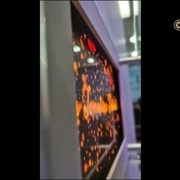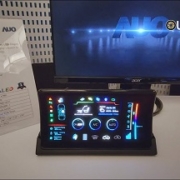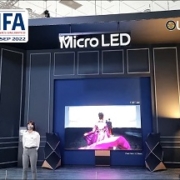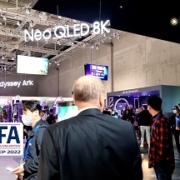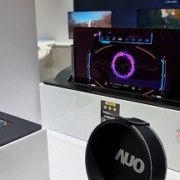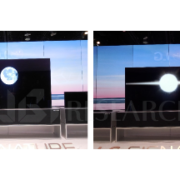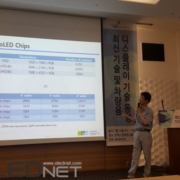Posts
“AI/AR Glasses Growth, Significant Expectations for the Development of Micro-LED Displays”
/in /by olednetAI technology is making a soft landing and the AI era is opening up. Recently, the competition among big tech companies to become the winner of the AI war has become more intense. It is expected that the multimodal technology of AI will renew the market’s perception of AI functions through interactions such as voice, video, and photos. AI/AR glasses are expected to be more popular as they have a viewing function and are equipped with various sensors such as cameras, microphones, and speakers to access data, voice, or displays in real time to complete interactions. Accordingly, AI/AR glasses have received a lot of attention in the past year.
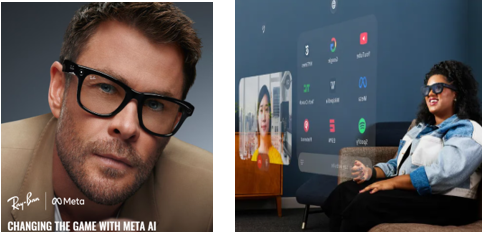
Ray-Ban META AI Glasses (left) and META Orion AR Glasses Prototype (right) (source: META)
The Ray-Ban smart glasses can be seen as Meta’s present, and the Orion project as its future. In September 2024, Meta unveiled the Orion glasses prototype, showcasing the new possibilities of AR glasses with innovative display technology. Micro LED was adopted as the display solution for the Orion AR glasses. AR glasses require ultra-high brightness (5,000 nits or more, ideally 10,000 nits or more) to be visible in outdoor environments. In addition, micro-LEDs are essential for lightweight, compact display engines that are required for AR glasses to be very slim and stylish when they are worn.
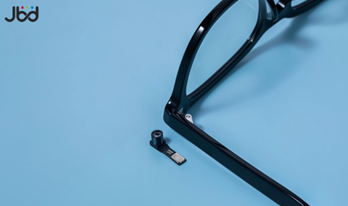
JBD “Hummingbird Mini II” mono-color engine (0.15cc, 0.3 grams) and daily-use glasses (source: JBD)
“AI” was the highlight of CES 2025, and AI smart glasses were one of the main attractions. Companies such as Vuzix, Rokid, Goertek, and RayNeo introduced new AI glasses products that use micro-LEDs.
Among the manufacturers of micro-LED displays, China’s Jade Bird Display (JBD), a company specializing in micro-LED microdisplays, has begun mass production at its facility in Hefei with a manufacturing capacity of more than 100 million 0.13-inch micro-LED panels per year. In addition to US and European companies, Chinese and Taiwanese companies such as Sitan and Raysolve are moving quickly to develop and prepare for the production of LEDoS displays. At UBI Research’s seminar held on on February 14, a presentation was given on micro-LED technologies for XR and trends in the industry. AI glasses began to blossom in 2024 with the development of AI and AR technology, and more large manufacturers are expected to enter the market in 2025. AI/AR smart glasses are expected to promote the accelerated development of the AI/AR industry, and there are high expectations for the development of micro-LED technology.
UBI Research published a report on micro-LED technology for XR in January. This report summarizes the technology related to the production of LEDoS panels required for XR glasses. It will help to improve the understanding of LEDoS’s micro-LED technology and will be an important reference for companies developing micro-LED display technologies to plan the future direction of technological development.
UBI Research Nam Deog Kim Analyst(ndkim@ubiresearch.com)

Samsung Display’s First Micro LED Watch
/in Display, Display, Display, Display, Focus on /by olednetCES 2025 in Las Vegas set the stage for Samsung Display’s private booth at the Encore Hotel. Among its cutting-edge OLED technologies, the highlight was the rare appearance of Micro LED. After years of quiet development, Samsung Display debuted its Micro LED for watches for the first time
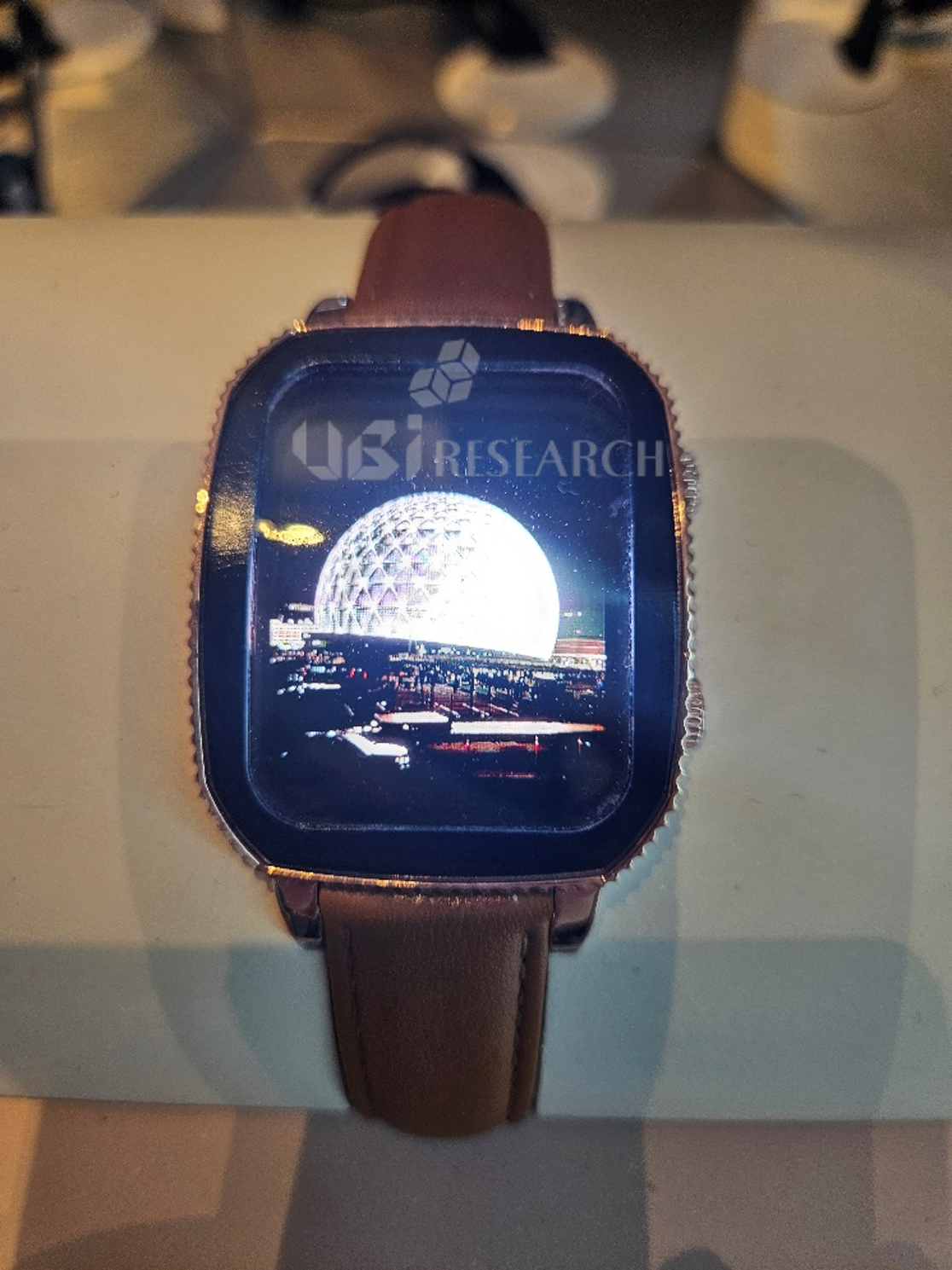
Samsung Display’s Micro LED features a 2.1-inch size, a resolution of 418×540, and a pixel density of 326 PPI, delivering a brightness of over 4,000 nits.
International Business Conference: 2024 OLED Korea & 2024 eXtended Reality Korea will be held in parallel!
/in Focus on, Focus on, Focus on, Focus on /by olednet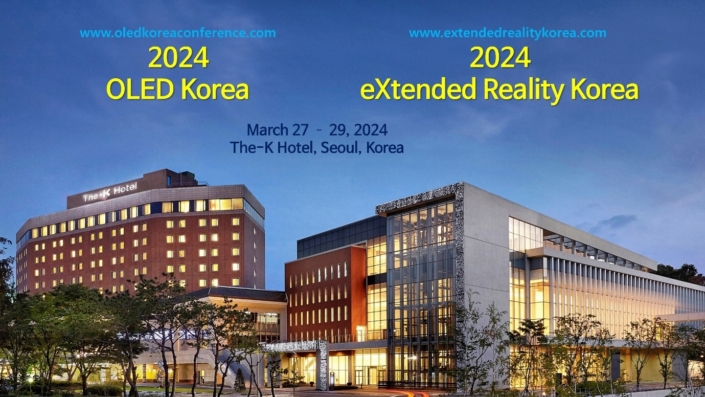
UBI Research, a display specialist research company, will hold the international business conferences OLED Korea and eXtended Reality Korea in parallel at The-K Hotel in Yangjae, Seoul from March 27 to 29, 2024. This event is expected to be an opportunity for people from companies, academia, and research institutes related to the display industry around the world to attend, exchange the best information, and form a global network.
eXtended Reality Korea is the first XR industry-related business conference held by UBI Research and will cover trends and outlook on micro display, XR Hardware/Software, materials, equipment, etc.
This event aims to provide attendees with the opportunity to deeply explore the display and XR areas through a comprehensive program including tutorials, keynote presentations, and panel discussions.
The tutorial on March 27th will feature presentations on the future of XR, micro LED display technology, and key technologies to realize the next generation OLED display.
In addition, keynote presentations by ▲UBI Research, ▲Samsung Display, ▲LG Display, ▲Hyundai Mobis, and ▲Fortell Games are scheduled for the conference to be held on March 28th and 29th. Choong-Hoon Yi, CEO of UBI Research, will give a presentation on “OLED and XR industry outlook.” We will present the overall OLED industry, including OLED for IT, and the micro OLED industry that will be applied to MR equipment.
Samsung Display plans to introduce SDC’s roadmap for expanding the AR/VR market based on SDC’s plan to overcome technical obstacles in ultra-high-resolution displays under the title “AR/VR Development Strategy for Future Display.”
Under the theme of “Life with OLED,” LG Display will examine the field of OLED displays applied in daily life and present the continuous evolution and benefits of OLED technology.
Under the theme of “Automotive Display / HUD Trend and Future Display,” Hyundai Mobis presents trends and requirements for automotive displays, from Pillar To Pillar displays to Rollable displays, predicts future automotive displays, and announces development strategies.
Lastly, Fortell Games will discuss the topic of “Next-Gen Mixed Reality: New Horizons for Spatial Computing”, analyzing the latest developments in mixed reality technology and their impact on the future of the gaming industry.
In addition, it will be run by a total of 34 domestic and foreign speakers and programs, including AR/VR development and technology, automotive displays, OLED industry, backplane technology, and MicroLED display development.
Because it is a parallel event, attendees can attend both events even if they register for one event, and registration is possible at a special discount price during the early bird period until February 29th.
Detailed information can be found on the website (https://oledkoreaconference.com/, https://extendedrealitykorea.com/).
[2022 Vehicle Displays] AUO (22 inch AmLED, 9.4 inch Flexible Micro LED)
/in Video /by olednet22 inch Passenger Display : Active Privacy
– Specifications –
LCD Tech : AHVA / LTPS / VAC
Resolution (pixel) 4K 1K
Active Area : 539mm (H) x 95mm (V)
Privacy Performance : Brightness 1.65% at H = 25⁰
Color Depth : 24 bits
Color Gamut 72% NTSC
Curvature : R3000 -Concave
Brightness : 600 cd/m²
9.4 inch Flexible Micro LED Display
– Specifications –
Resolution (pixel) : 1920 x 960
Refresh Rate : 60 Hz
Brightness : > 2000 cd/m²
Contrast Ratio : 1,000,000 :1
Color Gamut : 120% NTSC
Pixel Configuration : Real RGB Stripe
Display L/R border : 3mm
ViewingAngle (U/D/L/R) : 179° / 179° / 179° / 179°
LED Size : > 30um
[IFA 2022] LG Electronics Micro LED TV, QNED 8K TV(MiniLED)
/in Video, Video, Video, Video, Video /by olednet#ifa2022 #lg #ledtv

https://ubiresearch.com/en/

https://en.olednet.com/

marketing@ubiresearch.com
+82-2-577-4391
[IFA 2022] Samsung Booth (MICRO LED, Neo QLED)
/in /by olednet#ifa2022 #samsung #qled

https://ubiresearch.com/en/

https://en.olednet.com/

marketing@ubiresearch.com
+82-2-577-4391
[SID 2022] AUO 14 6” Rollable Micro LED Display Display Week 2022
/in Oled Video /by olednetResolution (pixel) : QHD (2560 x RGB x 1440)
Pixel Density : 202PPI
Brightness :1,000 cm/m²
Contrast Ratio : 1,000,000 : 1
Color Gamut : 100% NTSC
Pixel Configuration : Color Conversion
Viewing Angle : 179° / 179° / 179° / 179°
LED Size : 30um
CES2019, the Biggest Issue of TV is LG Electronics OLED TV R
/in Display /by olednetReporter : Daejeong Yoon
The CES, held in early January of each year, is the most important event to understand all of the consumer electronics trends of the year. This year, TV makers from all over the world exhibited a variety of products to attract spectators to the event.
When OLED TV occupied more than 50% of the premium TV market with more than $ 2,000, the LCD TV industry sought to prevent the OLED TV market from expanding by exhibiting 8K LCD TVs to CES. However, the attention and admiration of the spectators were poured into OLED TV R.
The 8K TV market began to open slightly from last year, in preparation for the 8K broadcast starting from the Tokyo Olympics in 2020. LCD TV companies displayed 8K LCD TVs of various sizes to preoccupy the market with the keyword of 8K. LCD TV, however, has not been recognized by viewers as a new TV product since Sharp has already exhibited steadily.
Another reason is OLED TV R displayed by LG Electronics. In the main body with built-in speaker, OLED TV rises up and goes down again. A lot of people came to see OLED TV R to shoot.
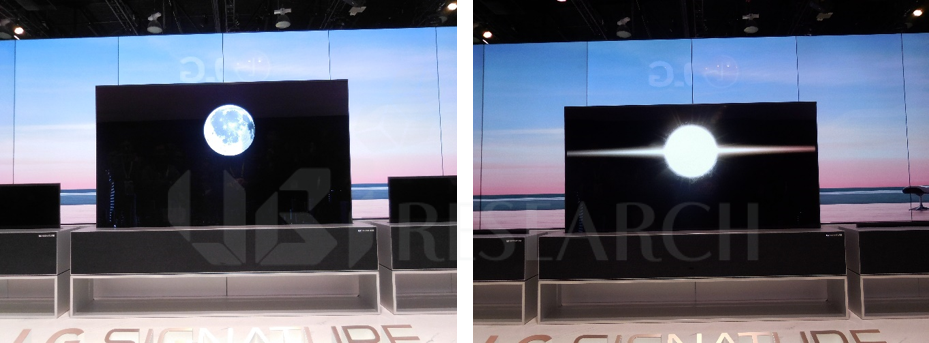
<LG Electronics, OLED TV R>
Last year, micro LED TVs became more prominent. In addition to Samsung Electronics, Sony, TCL and Hisense exhibited micro LED TVs this year. It seems that the gap of micro LED TV technology between Korean companies and Chinese companies is only about one year. In the micro LED TV market based on assembly technology that does not require special manufacturing technology, China, which is the world’s best LED industry and infrastructure, is expected to dominate the market soon.
However, as LG Display has a unique OLED TV manufacturing technology, which has a very complicated panel structure and manufacturing process, the technological gap between Korea and China is expected to be more than five years difference. In this situation, OLED TV R, released by LG Electronics, once again realizes that Korea’s OLED technology is the best in the world.
On the other hand, TV companies’ display of OLED TVs, except for LG Electronics, has stagnated. These companies are not yet receiving 8K OLED panels and rollable OLED panels from LG Display. Even Sony does not have any special features, only OLED TVs that are well known so far.
As a result, the CES TV show was notable only for LG Electronics.
It is judged that LCD TV using mini LED that TCL has released can compete with OLED TV in this exhibition. The contrast ratio is displayed as 1,000,000: 1 similar to OLED TV. Black is a very good product that has a vibrant color and contrast ratio similar to OLED TV. However, a holo-effect was found around the bright screen displayed on the black desktop. It is a phenomenon that the surroundings appear to spread brightly. As it is invisible to non-specialists, it is competitive in price and is a product that can compete well with OLED TVs.
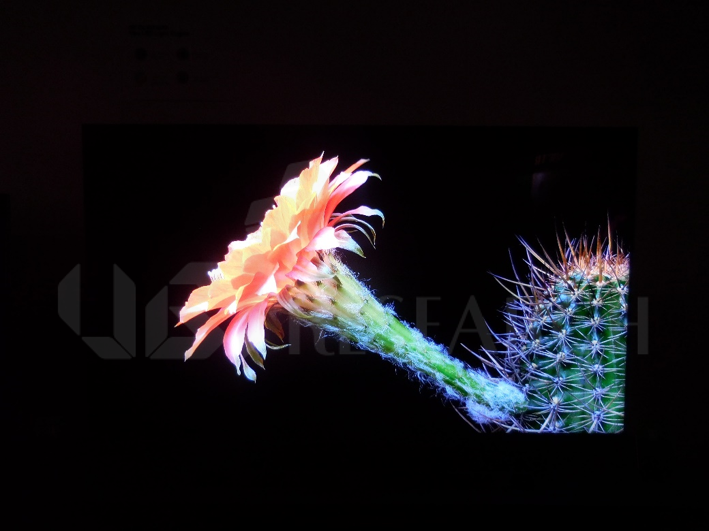
< TCL, 8K QLED TV with mini LED>
What is the next-generation display poised to outshine OLED?
/in /by olednetThe micro LED, QLED and hologram, which are referred to as the next generation displays, were presented at the seminar entitled ‘Recent Trends in Display and Vehicle Display Technology’ hosted by UBI Research on the 14th.
Under the theme ‘Technical Issues of micro LED Display and Market Trend’, professor Moon Dae-gyu of Soonchunhyang University said, “Micro LED can be realized in high resolution and it is easy to implement curved display or flexible display because there is no limit of panel shape and size” He added “When applying micro LED to a display, high resolution is feasible even on a small substrate size, so that it can be applied to VR, etc.” and expected “When applied to a public display, it will be able to escape from the method of tiling many display panels”. However, there remain some technical problems such as the problem of transferring and connecting millions of LED chips quickly and accurately, the deviation problem of color and luminous efficiency between LED chips, and the technical problem of implementing an active matrix for the application of a display.

<Professor Moon Dae-gyu of Soonchunhyang University>
Next, Dr. Hwang Do-Kyung of Korea Institute of Science and Technology(KIST), Dr. Bae Wan-ki, senior researcher of KIST, and Dr. Oh Min-Suk of Korea Electronics Technology Institute(KETI) announced the manufacturing principle of quantum dot and the possibility of self-emitting QLED using it. Dr. Hwang said, “The quantum dot has the advantage of not only color change depending on the size and but also narrow half width.” “Self-emitting QLED can display higher color purity than OLED.” he added.
Dr. Bae expected “If research is carried out on an enterprise scale, the speed of technology development will increase more rapidly.” saying that “At present, the efficiency of quantum dot devices is continuously improving, but the life span is insufficient compared to OLED.”
“We need the next generation display technology to follow the LCD and OLED,” said Dr. Oh Min-Seok of Korea Electronics Technology Institute(KETI). He added “QLED is attracting much attention as a next-generation display, but there remain such issues as too much focus on the development of emitting devices, the lack of solution process-related devices and technologies, and the non-cadmium-based high-efficiency blue light emitting devices”.

<Dr. Oh Min-Seok of Korea Electronics Technology Institute(KETI)>
As the last speaker, Kang, Hoon-Jong, team leader of Korea Electronics Technology Institute(KETI) explained the digital hologram technology and its application, and emphasized that a display panel capable of expressing the hologram is necessary to implement it. He said “We have a holographic printer or a microscope but there is no enough technology to apply it to TV”. Then, he closed his presentation saying “We need to develop a film for hologram first and then a functional design that can implement the screen.”
During the presentation about the next generation display, many of the speakers emphasized the importance of cooperation and participation among schools, research institutes and companies in order to overcome technical problems and realize them as actual displays. The display competition is expected to become even more intense in the future, as R&D in micro OLED, QLED, and hologram, which are considered as the next generation display, is concentrated.
영문 풋터
UBI RESEARCH / CEO:Choong Hoon Yi / Business License Registration Number 220-87-44660
ADDRESS: A-1901, Samho Moolsan Bldg, 83, Nonhyeon-ro, Seocho-gu, Seoul, Republic of Korea (Zip) 06775 TEL:+82-2-577-4390 / E-MAIL:marketing@ubiresearch.com

